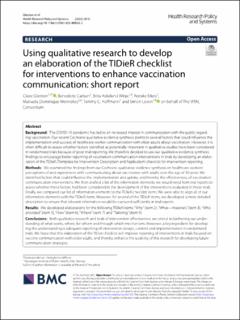| dc.contributor.author | Glenton, Claire | |
| dc.contributor.author | Carlsen, Benedicte | |
| dc.contributor.author | Winje, Brita Askeland | |
| dc.contributor.author | Eilers, Renske | |
| dc.contributor.author | Wennekes, Manuela Dominique | |
| dc.contributor.author | Hoffmann, Tammy C | |
| dc.contributor.author | Lewin, Simon | |
| dc.date.accessioned | 2022-06-07T11:25:44Z | |
| dc.date.available | 2022-06-07T11:25:44Z | |
| dc.date.created | 2022-03-21T10:35:37Z | |
| dc.date.issued | 2022 | |
| dc.identifier.issn | 1478-4505 | |
| dc.identifier.uri | https://hdl.handle.net/11250/2997696 | |
| dc.description.abstract | Background
The COVID-19 pandemic has led to an increased interest in communication with the public regarding vaccination. Our recent Cochrane qualitative evidence synthesis points to several factors that could influence the implementation and success of healthcare worker communication with older adults about vaccination. However, it is often difficult to assess whether factors identified as potentially important in qualitative studies have been considered in randomized trials because of poor trial reporting. We therefore decided to use our qualitative evidence synthesis findings to encourage better reporting of vaccination communication interventions in trials by developing an elaboration of the TIDieR (Template for Intervention Description and Replication) checklist for intervention reporting.
Methods
We examined the findings from our Cochrane qualitative evidence synthesis on healthcare workers’ perceptions of and experiences with communicating about vaccination with adults over the age of 50 years. We identified factors that could influence the implementation and uptake, and thereby the effectiveness, of vaccination communication interventions. We then drafted a list of the information elements we would need from trial reports to assess whether these factors had been considered in the development of the interventions evaluated in these trials. Finally, we compared our list of information elements to the TIDieR checklist items. We were able to align all of our information elements with the TIDieR items. However, for several of the TIDieR items, we developed a more detailed description to ensure that relevant information would be captured sufficiently in trial reports.
Results
We developed elaborations for the following TIDieR items: “Why” (item 2), “What—materials” (item 3), “Who provided” (item 5), “How” (item 6), “Where” (item 7) and “Tailoring” (item 9).
Conclusions
Both qualitative research and trials of intervention effectiveness are critical to furthering our understanding of what works, where, for whom and through which mechanisms. However, a key ingredient for developing this understanding is adequate reporting of intervention design, content and implementation in randomized trials. We hope that this elaboration of the TIDier checklist will improve reporting of interventions in trials focused on vaccine communication with older adults, and thereby enhance the usability of this research for developing future communication strategies. | en_US |
| dc.language.iso | eng | en_US |
| dc.publisher | BioMed Central | en_US |
| dc.rights | Navngivelse 4.0 Internasjonal | * |
| dc.rights.uri | http://creativecommons.org/licenses/by/4.0/deed.no | * |
| dc.title | Using qualitative research to develop an elaboration of the TIDieR checklist for interventions to enhance vaccination communication: short report | en_US |
| dc.type | Journal article | en_US |
| dc.type | Peer reviewed | en_US |
| dc.description.version | publishedVersion | en_US |
| dc.rights.holder | Copyright 2022 The Author(s) | en_US |
| dc.source.articlenumber | 31 | en_US |
| cristin.ispublished | true | |
| cristin.fulltext | original | |
| cristin.qualitycode | 1 | |
| dc.identifier.doi | 10.1186/s12961-022-00833-2 | |
| dc.identifier.cristin | 2011281 | |
| dc.source.journal | Health Research Policy and Systems | en_US |
| dc.identifier.citation | Health Research Policy and Systems. 2022, 20, 31. | en_US |
| dc.source.volume | 20 | en_US |

